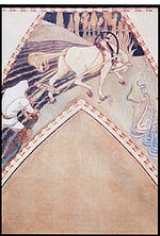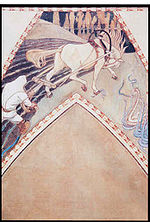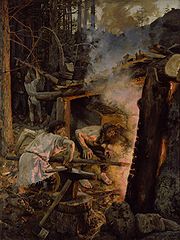
Ilmarinen
Encyclopedia


Blacksmith
A blacksmith is a person who creates objects from wrought iron or steel by forging the metal; that is, by using tools to hammer, bend, and cut...
and inventor in the Kalevala
Kalevala
The Kalevala is a 19th century work of epic poetry compiled by Elias Lönnrot from Finnish and Karelian oral folklore and mythology.It is regarded as the national epic of Finland and is one of the most significant works of Finnish literature...
, is an archetypal
Archetype
An archetype is a universally understood symbol or term or pattern of behavior, a prototype upon which others are copied, patterned, or emulated...
artificer from Finnish mythology
Finnish mythology
Finnish mythology is the mythology that went with Finnish paganism which was practised by the Finnish people prior to Christianisation. It has many features shared with fellow Finnic Estonian mythology and its non-Finnic neighbours, the Balts and the Scandinavians...
. ("Seppo
Seppo
Seppo is a given name, and may refer to:* Seppo Evwaraye , Finnish National Football League offensive guard* Seppo Kääriäinen , Finnish politician* Seppo Kolehmainen , Finnish film actor...
" is a popular boy's name and the Finnish word for smith "seppä" is derived from it, or vice versa.) Immortal, he is capable of creating practically anything, but is portrayed as unlucky in love. He is described as working the known metals of the time, including brass, copper, iron, gold and silver. The great works of Ilmarinen include the crafting of the dome of the sky and the forging of the Sampo
Sampo
In Finnish mythology, the Sampo or Sammas was a magical artifact of indeterminate type constructed by Ilmarinen that brought good fortune to its holder...
.
Other names for Ilmarinen that are found in rune variants include Ilmorinen and Ilmollini. The name Ilmarinen is also close to that of the Udmurt
Udmurt
Udmurt may refer to:*Udmurt people, people who speak the Udmurt language*Udmurt language, a Finno-Ugric language*Udmurt Republic, a federal republic of Russia*Udmurt Autonomous Oblast, an autonomous oblast of the Soviet Union...
deity Inmar. Originally a sky god credited with creating the sky (ilma means air in Finnish
Finnish language
Finnish is the language spoken by the majority of the population in Finland Primarily for use by restaurant menus and by ethnic Finns outside Finland. It is one of the two official languages of Finland and an official minority language in Sweden. In Sweden, both standard Finnish and Meänkieli, a...
), he is believed to have taken on the qualities of a smith through the Proto-Finnic
Finnic languages
The term Finnic languages often means the Baltic-Finnic languages, an undisputed branch of the Uralic languages. However, it is also commonly used to mean the Finno-Permic languages, a hypothetical intermediate branch that includes Baltic Finnic, or the more disputed Finno-Volgaic languages....
contact with the Indo-European
Indo-European
Indo-European may refer to:* Indo-European languages** Aryan race, a 19th century and early 20th century term for those peoples who are the native speakers of Indo-European languages...
Balts
Balts
The Balts or Baltic peoples , defined as speakers of one of the Baltic languages, a branch of the Indo-European language family, are descended from a group of Indo-European tribes who settled the area between the Jutland peninsula in the west and Moscow, Oka and Volga rivers basins in the east...
. He is also directly appealed to for aid in several incantation runes. Insofar as Elias Lönnrot
Elias Lönnrot
Elias Lönnrot was a Finnish philologist and collector of traditional Finnish oral poetry. He is best known for compiling the Kalevala, the Finnish national epic compiled from national folklore.-Education and early life:...
heavily redacted the original runes collected by him and others, it's valuable to differentiate between the Kalevala
Kalevala
The Kalevala is a 19th century work of epic poetry compiled by Elias Lönnrot from Finnish and Karelian oral folklore and mythology.It is regarded as the national epic of Finland and is one of the most significant works of Finnish literature...
and the original poems sung by rune singers.
From the Kalevala
When the old sage, VäinämöinenVäinämöinen
Väinämöinen is the central character in the Finnish folklore and the main character in the national epic Kalevala. His name comes from the Finnish word väinämö, meaning minstrel. Originally a Finnish god, he was described as an old and wise man, and he possessed a potent, magical...
, was traveling wide in the search of a wife, he was captured by the old mistress of Pohjola
Pohjola
Pohjola or Pohja is a location in Finnish mythology, sometimes translated in English as Northland or Pohjoland. It is one of the two main polarities in the Finnish national epic, the Kalevala, along with Kaleva or Väinölä. Its name is derived from the word pohjoinen meaning the compass point north...
, the land of the North. In return for giving him safe passage from the land of Pohjola back to his native country, the enchantress Louhi
Louhi
Louhi is a queen of the land known as Pohjola in Finnish mythology and the mythology of Lapland.-In mythology:Louhi is described as a powerful witch with the ability to change shape and weave mighty enchantments. She is also the main opponent of Väinämöinen and his group in the battle for the...
of Pohjola wanted to have made the Sampo
Sampo
In Finnish mythology, the Sampo or Sammas was a magical artifact of indeterminate type constructed by Ilmarinen that brought good fortune to its holder...
, a magic artifact. Väinämöinen replied that he could not make her one, but that Ilmarinen could, and promised to send the great smith to Pohjola to do just that. In return for this wondrous device, Louhi would also give Ilmarinen her daughter's hand in marriage.
On having returned home, Väinämöinen tries to awe Ilmarinen with tales of the maiden's beauty and so lure him to Pohjola. Ilmarinen sees through the ruse, however, and refuses. Not to be outdone, Väinämöinen tricks the smith into climbing a fir tree trying to bring down moonlight that is glimmering on the branches. Conjuring a storm-wind with his magical song, Väinämöinen then blows Ilmarinen away to Pohjola.
Once there, Ilmarinen is approached by the toothless hag, Louhi
Louhi
Louhi is a queen of the land known as Pohjola in Finnish mythology and the mythology of Lapland.-In mythology:Louhi is described as a powerful witch with the ability to change shape and weave mighty enchantments. She is also the main opponent of Väinämöinen and his group in the battle for the...
, and her daughter, the Maiden of Pohjola, and having seen the maiden's beauty, consents to build a Sampo. For three days, he sought a place to build a great forge. In that forge he placed metals and started working, tending the magic fire with help of the slaves of Pohjola.
On the first day, Ilmarinen looked down into the flames and saw that the metal had taken the form of a crossbow with a golden arch, a copper shaft and quarrel-tips of silver. But the bow had an evil spirit, asking for a new victim each day, and so Ilmarinen broke it and cast the pieces back into the fire.
On the second day, there came a metal ship from the fire, with ribs of gold and copper oars. Though beautiful to behold, it too was evil at heart, being too eager to rush towards battle, and so, Ilmarinen broke the magic boat apart and cast back the pieces once more.
On the third day, a metal cow emerged, with golden horns and the sun and the stars on its brow. But alas, it was ill-tempered, and so the magical heifer was broken into pieces and melted down.
On the fourth day, a golden plow is pulled from the forge, with a golden plowshare, a copper beam and silver handles. But it too is flawed, plowing up planted fields and furrowing meadows. In despair, Ilmarinen destroys his creation once more.
Angered at his lack of success, Ilmarinen conjures the four winds to fan the flames. The winds blow for three days, until finally, the Sampo is born, taking the shape of a magic mill that produces grain, salt and gold. Pleased with his creation at last, Ilmarinen presents it to Louhi, who promptly locks it in a vault deep underground.
Returning triumphant to the Maiden of Pohjola, Ilmarinen bids her to become his wife. To his dismay, she refuses to leave her native land, forcing him to return home alone and dejected.
From original rune variants
Variants of the original runes used by Lönnrot in compiling the Kalevala present a different picture of Ilmarinen. In one variant of The Sampo, for example, Ilmarinen goes willingly to Pohjola to forge the Sampo, not because he was tricked by Väinämöinen, but in order to redeem Väinämöinen from death. In addition, the same rune portrays Ilmarinen as returning home successfully with the Maiden of the North.Ilmarinen's portrayal as "unlucky in love" in the Kalevala is primarily due to Lönnrot's own choices while revising and compiling the original runes to form a cohesive narrative. In another example from an original rune entitled Kosinta (The Courtship), Ilmarinen takes a journey to compete for Hiisi's daughter. He again succeeds in obtaining his wife after completing the tasks of ploughing a field of vipers, bringing Tuoni's bear, and bringing the pike of Tuoni.
From the Kalevala
After the loss of his first wife to KullervoKullervo
In the Finnish Kalevala, Kullervo was the ill-fated son of Kalervo. He is the only irredeemably tragic character in Finnish mythology.-Rune 31 - Kullervo, son of Evil:...
's curse, the disheartened Ilmarinen attempts to craft a new one from gold and silver, but finds the golden wife hard and cold. Dismayed, he attempts to wed her to his brother Väinämöinen instead, but the old sage rejects her, saying that the golden wife ought to be cast back into the furnace and tells Ilmarinen to "forge from her a thousand trinkets". Speaking to all of his people, he further adds:
"Every child of Northland, listen,
Whether poor, or fortune-favored:
Never bow before an image
Born of molten gold and silver:
Never while the sunlight brightens,
Never while the moonlight glimmers,
Choose a maiden of the metals,
Choose a bride from gold created
Cold the lips of golden maiden,
Silver breathes the breath of sorrow."
The tale of the Golden Wife can be seen as a cautionary tale based on the theme of "money cannot buy happiness". To a contemporary reader, there is also a similarity to the hubristic nature of the Golem
Golem
In Jewish folklore, a golem is an animated anthropomorphic being, created entirely from inanimate matter. The word was used to mean an amorphous, unformed material in Psalms and medieval writing....
legend, or to Frankenstein
Frankenstein
Frankenstein; or, The Modern Prometheus is a novel about a failed experiment that produced a monster, written by Mary Shelley, with inserts of poems by Percy Bysshe Shelley. Shelley started writing the story when she was eighteen, and the novel was published when she was twenty-one. The first...
, in that even the most skilled of mortals cannot rival divine perfection when creating life.
From original rune variants
In another example of Lönnrot's editorial license, the Kullervo cycle originally existed as an independent series of runes. In his effort to create a homogeneous narrative, Lönnrot presented Kullervo as Ilmarinen's slave in order to insert Kullervo into the Sampo cycle of runes. However, some scholars are convinced that the Golden Bride was originally an independent rune that was eventually added to the Sampo cycle. Furthermore, independent variants of the Kultamorsian (Golden Bride) rune have been collected. In Matti KuusiMatti Kuusi
Matti Kuusi was a Finnish folklorist, paremiographer and paremiologist. He wrote several books and a number of articles on Finnish folklore. He was the first to have introduced the type system of proverbs à la AT System of folklore, the Matti Kuusi international type system of proverbs...
's opinion, the warning reproduced above is a secondary element that was probably added during the Christian period. Rather than serving as a cautionary tale, the original runes probably expressed the widespread myth of a golden woman found throughout Arctic Eurasia
Eurasia
Eurasia is a continent or supercontinent comprising the traditional continents of Europe and Asia ; covering about 52,990,000 km2 or about 10.6% of the Earth's surface located primarily in the eastern and northern hemispheres...
.

